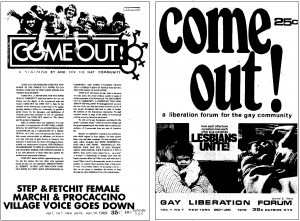VIEWED THROUGH THE PRISM of the eight issues of the newspaper Come Out! that were published by the Gay Liberation Front (GLF) in New York from 1969 to 1972, the Stonewall Riots ignited a decisive and twofold political trajectory that has endured for forty years. Two political models, distinct and dissimilar but not mutually exclusive, developed simultaneously. The first approach sustained and refined the paradigm of identity politics rooted in the homophile movement. The second introduced a critical reformulation of gender and sexuality that evolved from feminism into the matrix of academia as lesbian and gay studies and subsequently queer theory.
The premier issue of Come Out! was published in November 1969. The choice of title, with its  exclamation mark following a command, was meant to suggest a sense of urgency. Early liberationists understood that “coming out” had the capacity to be transformative because it turned a personal action into a political statement. The mission statement on the first page boldly proclaimed: “Come out for freedom! Power to the people! Gay power to gay people!” This rhetorical departure from the idiom of the early homophile movement, which had favored an understated, non-threatening tone, occurred at a unique historical moment. The lesbian and gay movement burst onto a stage of extraordinary cultural turbulence at the height the anti-Vietnam War movement, marked by a vigorous civil rights struggle, an emergent second wave of feminism, and a burgeoning youthful counterculture.
exclamation mark following a command, was meant to suggest a sense of urgency. Early liberationists understood that “coming out” had the capacity to be transformative because it turned a personal action into a political statement. The mission statement on the first page boldly proclaimed: “Come out for freedom! Power to the people! Gay power to gay people!” This rhetorical departure from the idiom of the early homophile movement, which had favored an understated, non-threatening tone, occurred at a unique historical moment. The lesbian and gay movement burst onto a stage of extraordinary cultural turbulence at the height the anti-Vietnam War movement, marked by a vigorous civil rights struggle, an emergent second wave of feminism, and a burgeoning youthful counterculture.
All the issues of Come Out! reported on gay and lesbian activist demonstrations in New York City. The protests were militant and the rhetoric was confrontational. Protests occurred in Times Square and Greenwich Village; at sites of institutional bigotry such as St. Patrick’s Cathedral; and against media homophobia at the offices of Time and The Village Voice. The first gay pride march was held a year after the Stonewall Riots, an annual tradition that survives and thrives to this day.






